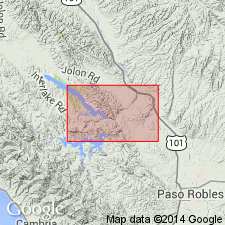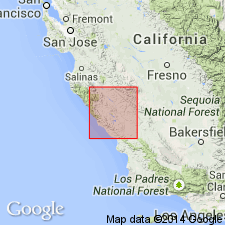
- Usage in publication:
-
- Tierra Redonda Formation*
- Modifications:
-
- Named
- Dominant lithology:
-
- Sandstone
- Conglomerate
- AAPG geologic province:
-
- California Coast Ranges province
Summary:
Unit is named the Tierra Redonda Formation. Consists of fine- to coarse-grained, thick-bedded, friable to well-cemented, white and yellowish-gray sandstone (calcareous in the lower part) and boulder conglomerate. Thickness is 1650 ft at type. Conformably overlies the Vaqueros Formation; conformably underlies the Sandholdt Member of the Monterey Shale. Age is early and middle Miocene. (B1520)
Source: GNU records (USGS DDS-6; Menlo GNULEX).

- Usage in publication:
-
- Tierra Redonda Formation*
- Modifications:
-
- Age modified
- Biostratigraphic dating
- AAPG geologic province:
-
- California Coast Ranges province
Summary:
Age of the Tierra Redonda Formation is modified from early and middle Miocene to: middle Miocene based on fossils [mollusks].
Source: GNU records (USGS DDS-6; Menlo GNULEX).
For more information, please contact Nancy Stamm, Geologic Names Committee Secretary.
Asterisk (*) indicates published by U.S. Geological Survey authors.
"No current usage" (†) implies that a name has been abandoned or has fallen into disuse. Former usage and, if known, replacement name given in parentheses ( ).
Slash (/) indicates name conflicts with nomenclatural guidelines (CSN, 1933; ACSN, 1961, 1970; NACSN, 1983, 2005, 2021). May be explained within brackets ([ ]).

